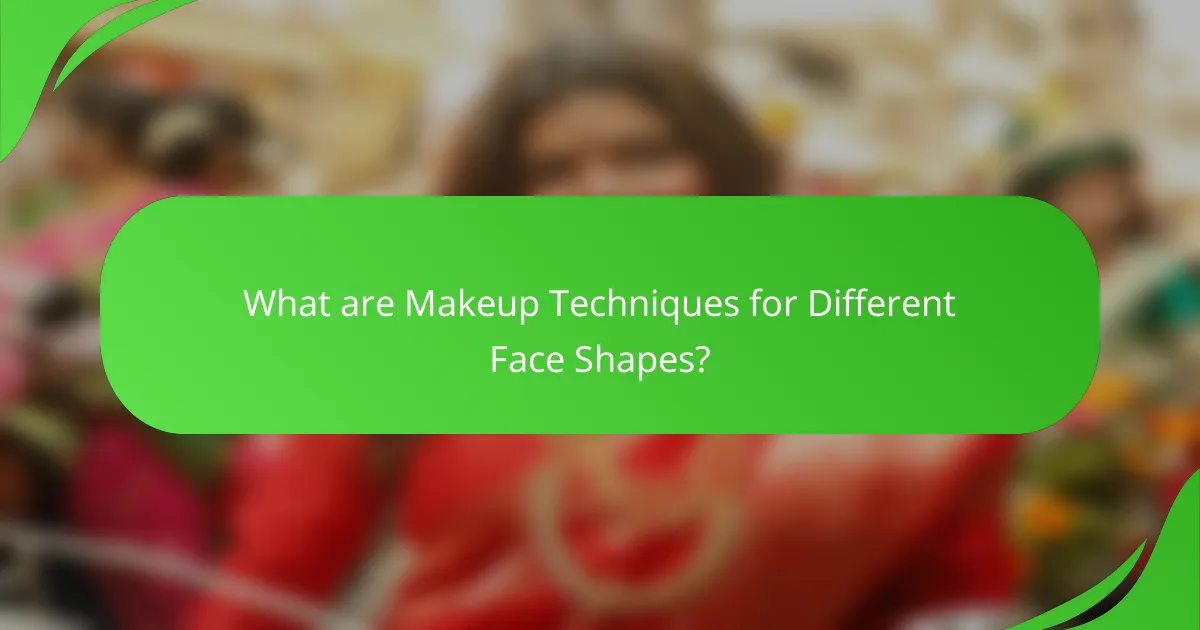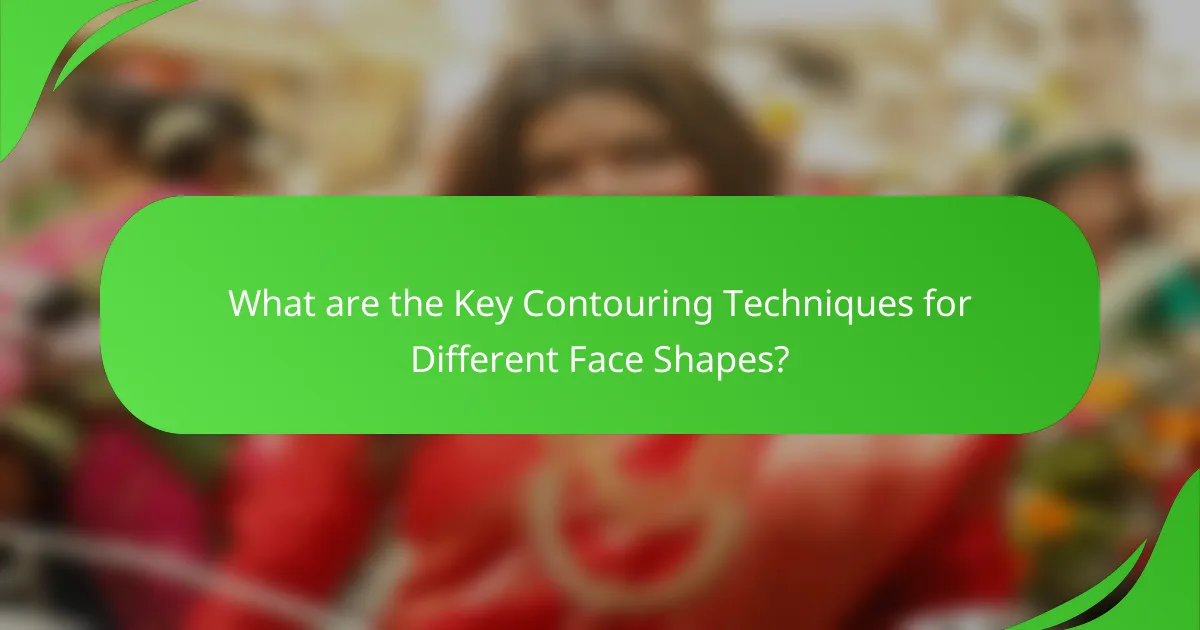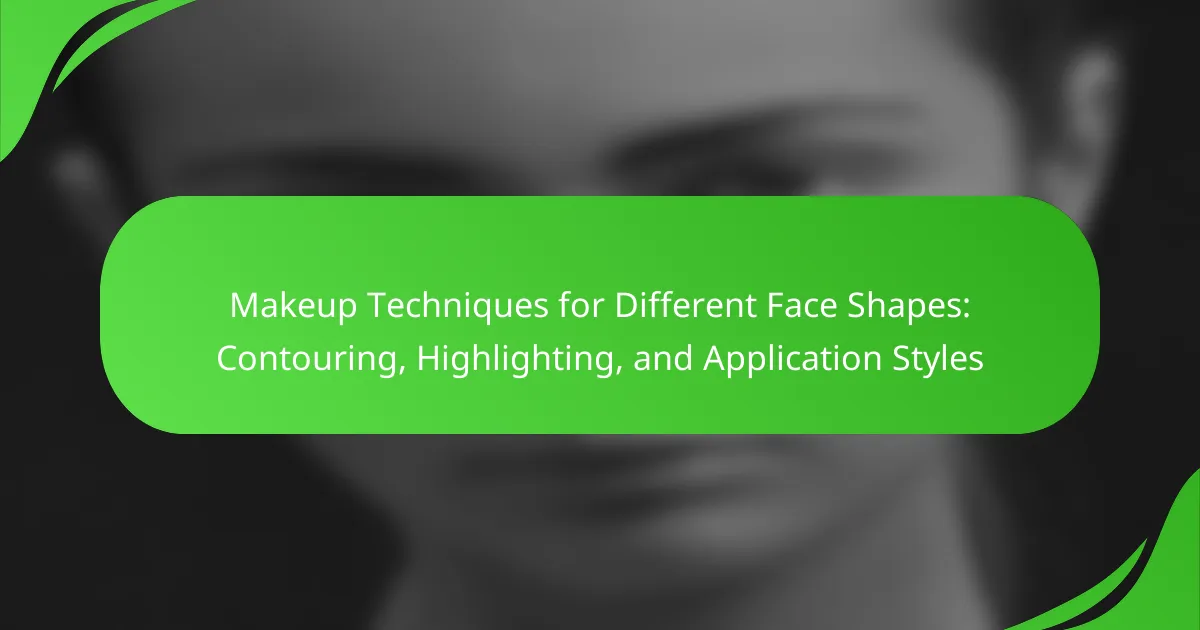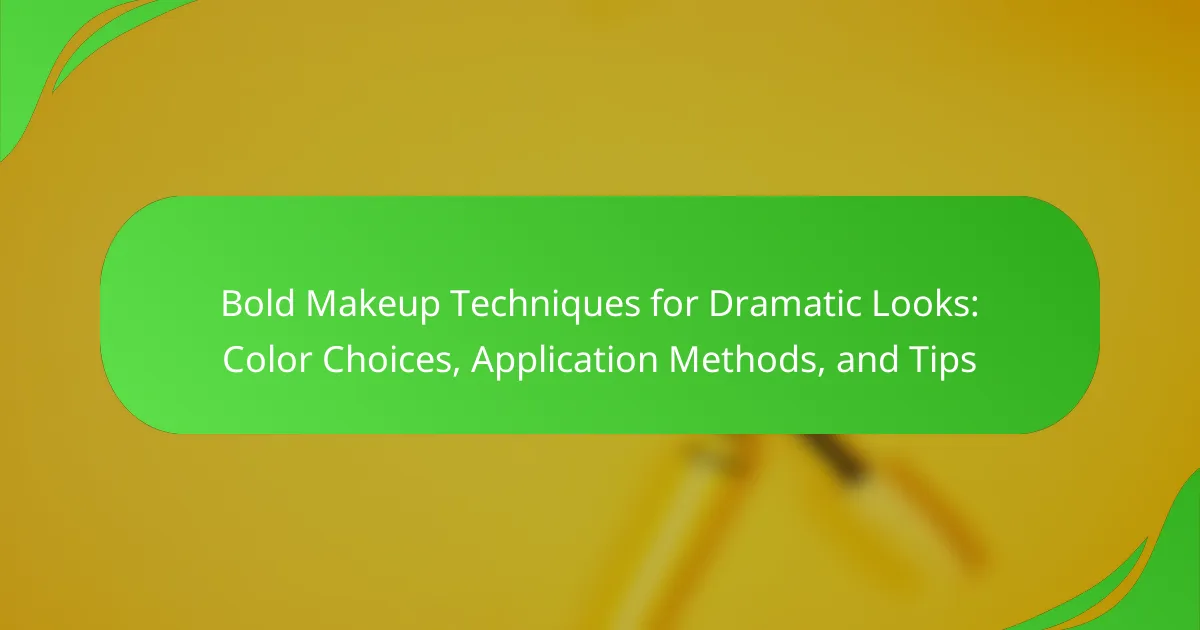Makeup techniques are tailored to different face shapes, including oval, round, square, heart-shaped, and long faces. Each face shape requires specific contouring and highlighting methods to enhance natural features and create a balanced appearance. For instance, oval faces benefit from minimal contouring, while round faces require contouring on the sides of the cheeks for elongation. Square faces should focus on softening the jawline, and heart-shaped faces need to balance proportions through targeted contouring and highlighting. Long faces can achieve width with strategic highlighting on the forehead and cheeks. These techniques are widely recognized in makeup artistry and are essential for achieving a sculpted look.

What are Makeup Techniques for Different Face Shapes?
Makeup techniques vary according to face shapes. For oval faces, contouring the sides of the forehead and jawline enhances natural symmetry. Round faces benefit from contouring the sides of the cheeks to create a longer appearance. Square faces should focus on softening the jawline with highlighting on the cheeks. Heart-shaped faces require contouring the forehead and highlighting the chin to balance proportions. Long faces can use contour on the forehead and chin to shorten the appearance. Each technique aims to enhance the natural features of the face shape. These methods are widely recognized in makeup artistry and supported by beauty professionals.
How do contouring, highlighting, and application styles differ for various face shapes?
Contouring, highlighting, and application styles vary significantly based on face shapes. For oval faces, contouring enhances the natural balance. Highlighting on the forehead and chin adds dimension. Round faces benefit from contouring along the sides of the face to elongate the appearance. Highlighting the center of the forehead and chin creates a focal point. Square faces require contouring at the jawline to soften angles. Highlighting the cheekbones emphasizes structure. Heart-shaped faces should contour the forehead and jawline for balance. Highlighting the center of the forehead and chin draws attention downward. Each technique is tailored to enhance the unique features of different face shapes, ensuring a harmonious look.
What are the basic principles of contouring for different face shapes?
Contouring involves applying makeup to enhance or reshape [censured] features based on face shape. For oval faces, contouring should focus on the forehead and chin to maintain balance. Square faces benefit from softening the jawline and adding dimension to the cheeks. Round faces require contouring along the sides of the face to create length. Heart-shaped faces should contour the forehead and jawline while highlighting the center of the face. Long faces need contouring on the forehead and chin to shorten the appearance. Each technique emphasizes specific areas to achieve a desired look, following the principles of enhancing natural features while considering individual face shapes.
How does highlighting enhance specific features on various face shapes?
Highlighting enhances specific features on various face shapes by drawing attention to key areas. It can accentuate cheekbones, brow bones, and the bridge of the nose. For oval faces, highlighting can emphasize the natural symmetry. For round faces, it elongates the appearance by highlighting the center of the forehead and chin. Square faces benefit from highlighting the cheekbones to soften angular features. Heart-shaped faces can use highlighting on the forehead and chin to balance the narrower jawline. According to makeup artists, strategic highlighting can create dimension and enhance [censured] structure effectively.
Why is understanding face shapes important in makeup application?
Understanding face shapes is crucial for effective makeup application. Different face shapes require tailored techniques for contouring and highlighting. For instance, round faces benefit from contouring along the sides to create the illusion of length. In contrast, square faces may need softer contours to soften angular features. Knowledge of face shapes leads to better balance and proportion in makeup looks. According to a study by the American Academy of Dermatology, personalized makeup techniques enhance overall appearance and confidence. Thus, understanding face shapes optimizes makeup application for individual features.
What are the common face shapes and their characteristics?
The common face shapes are oval, round, square, heart, and diamond. An oval face shape has balanced proportions with a slightly narrower jawline. A round face shape features full cheeks and a rounded chin. A square face shape has a strong jawline and equal width across the forehead and jaw. A heart face shape is characterized by a wider forehead and a narrow chin. Lastly, a diamond face shape has a narrow forehead and jawline with wider cheekbones. These classifications help in determining appropriate makeup techniques for each shape.
How does face shape influence makeup choices and techniques?
Face shape significantly influences makeup choices and techniques. Different face shapes require tailored approaches to enhance features. For example, oval faces benefit from balanced contouring along the jawline and forehead. Round faces often need contouring to elongate the appearance, typically using darker shades along the sides. Square faces can use softening techniques around the jaw and temples to create a more oval look. Heart-shaped faces may focus on highlighting the forehead and chin while contouring the sides of the face. Understanding these variations allows for more effective makeup application, ensuring that each shape is complemented appropriately.

What are the Key Contouring Techniques for Different Face Shapes?
Key contouring techniques vary based on face shapes. For oval faces, contouring is minimal. Focus on enhancing the forehead and chin. For round faces, contour the sides of the face to create length. Apply contour beneath the cheekbones for definition. Square faces benefit from softening the jawline. Contour the forehead and under the cheekbones. Heart-shaped faces require contouring on the forehead and chin. This creates balance. Long faces need contouring on the forehead and jawline. Highlight the cheeks to add width. Each technique aims to enhance natural features while providing a sculpted appearance.
How can contouring be tailored to specific face shapes?
Contouring can be tailored to specific face shapes by applying makeup strategically to enhance or minimize features. For oval faces, contouring along the jawline and temples can add definition. Square faces benefit from softening the jawline with contour on the edges. Round faces can use contour on the sides of the forehead and under the cheekbones to create the illusion of length. Heart-shaped faces should contour the forehead and under the chin to balance the face. Long faces require contouring on the sides of the forehead and under the chin to shorten the appearance. Each technique is designed to complement the unique structure of the face shape, creating a more balanced look.
What contouring techniques work best for oval faces?
For oval faces, the best contouring techniques involve softening the forehead and enhancing the cheekbones. Apply contour along the sides of the forehead to reduce width. Focus on the hollows of the cheeks to create dimension. Highlight the center of the forehead and the chin to maintain balance. The jawline can be subtly contoured to define shape without harsh lines. These techniques emphasize the natural symmetry of an oval face. According to makeup artists, this approach enhances features while preserving the face’s proportions.
How should contouring be approached for round faces?
Contouring for round faces should focus on creating the illusion of length and structure. Apply contour along the sides of the forehead to narrow it. Use contour under the cheekbones to add definition. Blend contour down towards the jawline to elongate the face. Highlight the center of the forehead, the tops of the cheekbones, and the chin to draw attention upward. This technique balances the face’s roundness and enhances its natural features. Research indicates that proper contouring can enhance [censured] structure by up to 20%, making it a valuable technique for round faces.
What tools and products are essential for effective contouring?
Essential tools and products for effective contouring include contour sticks, powders, and brushes. Contour sticks offer a creamy texture for easy application. Powders provide a matte finish and blend seamlessly into the skin. Brushes come in various shapes; angled brushes are ideal for precise application. A beauty sponge can also help blend products for a natural look. Highlighters complement contouring by adding luminosity to specific areas. Using these products enhances [censured] structure and creates dimension.
What types of contour products are available for different face shapes?
Contour products vary based on face shapes to enhance features. For oval faces, cream contour sticks work well for subtle definition. Square faces benefit from powder contours to soften angles. Round faces can use liquid contours for a sculpted appearance. Heart-shaped faces often utilize bronzers to balance the forehead and chin. Long faces may prefer stick contours for targeted application on the sides. Each product type aligns with the specific needs of the face shape, ensuring effective contouring.
How do different brushes and tools affect contouring results?
Different brushes and tools significantly affect contouring results. The type of brush influences the application technique and final look. For instance, dense brushes provide fuller coverage and a more dramatic contour. They are ideal for powder products that need to be built up. In contrast, fluffy brushes create a softer, blended appearance. They work well for cream products and achieve a more natural finish.
Sponges are versatile tools that can blend contour seamlessly into the skin. Their damp application technique helps to diffuse product for a flawless look. Additionally, contour sticks often come with built-in applicators, allowing for precise placement. Each tool’s shape and density affect how product adheres to the skin.
Using the right tool can enhance or diminish the contouring effect. For example, angled brushes are excellent for sculpting cheekbones due to their shape. Research shows that the right tool can increase application precision by up to 50%. This highlights the importance of choosing appropriate brushes and tools for desired contouring results.

How to Highlight Effectively for Different Face Shapes?
To highlight effectively for different face shapes, apply the highlighter strategically based on the shape’s characteristics. For oval faces, highlight the forehead, cheekbones, and chin for balance. For round faces, focus on the tops of the cheekbones and the bridge of the nose to elongate the appearance. For square faces, highlight the center of the forehead, tops of the cheekbones, and chin to soften angles. For heart-shaped faces, highlight the forehead and tops of the cheekbones, avoiding the chin. For long faces, apply highlighter on the forehead, cheekbones, and chin to create width. These techniques enhance features and create a more balanced look for each face shape.
What highlighting techniques complement various face shapes?
Highlighting techniques vary based on face shapes to enhance natural features. For oval faces, apply highlighter on the cheekbones and brow bones for a balanced look. Round faces benefit from highlighting the top of the cheekbones and the center of the forehead to elongate the face. Square faces should focus on the cheekbones and the jawline to soften angles. Heart-shaped faces require highlighting on the forehead and chin to draw attention downward. Long faces should highlight the cheeks and the sides of the forehead to create width. Each technique aims to accentuate the unique attributes of different face shapes.
How can highlighting enhance the features of square faces?
Highlighting can enhance the features of square faces by softening angular lines. It draws attention to specific areas, creating a more balanced appearance. Applying highlighter to the cheekbones adds dimension and lifts the face. Highlighting the center of the forehead can elongate the appearance of the face. Accentuating the brow bone can create a softer look. These techniques help to counteract the strong jawline typical of square faces. By focusing on these areas, highlighting promotes a more harmonious [censured] structure.
What are the best highlighting methods for heart-shaped faces?
The best highlighting methods for heart-shaped faces include focusing on the forehead, cheekbones, and chin. Highlighting the center of the forehead softens the appearance of a wider upper face. Applying highlighter to the tops of the cheekbones enhances their prominence and adds dimension. A subtle highlight on the chin balances the face by drawing attention downward. Using a lighter shade of highlighter helps create a luminous effect. Cream or liquid highlighters can provide a more natural finish. These methods are effective in emphasizing the unique features of a heart-shaped face.
What products are recommended for highlighting?
Cream highlighters are recommended for highlighting. They provide a dewy finish and blend seamlessly into the skin. Liquid highlighters are also effective, offering a luminous glow. Powder highlighters can create a more intense shine and are easy to apply. Stick highlighters offer convenience and portability. Popular brands include Becca, Fenty Beauty, and Anastasia Beverly Hills. These products have received positive reviews for their pigmentation and blendability.
What are the differences between cream and powder highlighters?
Cream highlighters are liquid or semi-solid products that provide a dewy finish. They blend seamlessly into the skin, making them ideal for dry or mature skin types. Cream highlighters can be applied with fingers or brushes for a natural look. They often contain moisturizing ingredients that enhance the skin’s texture.
Powder highlighters are dry formulations that offer a more matte finish. They are suitable for oily skin types and can be layered for intensity. Powder highlighters are typically applied with a brush and can be dusted over makeup. They tend to have a longer shelf life and are less prone to drying out.
The main difference lies in their formulation and finish. Cream highlighters offer hydration and a luminous glow, while powder highlighters provide a more defined shimmer. Each type serves different skin needs and desired effects.
How do different shades of highlighter suit various skin tones?
Different shades of highlighter complement various skin tones by enhancing natural undertones. For fair skin, shades like champagne or light pink provide a soft glow. Medium skin tones benefit from peachy or golden highlights that add warmth. Deep skin tones shine with bold colors like bronze or copper that create contrast. Each shade not only matches the skin tone but also reflects light differently. This interplay creates dimension and enhances [censured] features. Choosing the right shade can elevate makeup looks significantly.
What are the Best Application Styles for Makeup on Different Face Shapes?
The best application styles for makeup vary by face shape. For oval faces, balanced application enhances natural symmetry. For round faces, contouring along the sides helps elongate the appearance. Square faces benefit from softening angles with rounded blush and highlighter placement. Heart-shaped faces should emphasize the lower part of the face with bronzer and blush. Long faces require horizontal strokes to create width, particularly on the cheeks. Each style is tailored to enhance the unique features of the respective face shape.
How does the application style vary by face shape?
Application style varies significantly by face shape. Different face shapes require tailored techniques for contouring and highlighting. For oval faces, application is generally balanced with soft contours. Round faces benefit from contouring along the sides to elongate the appearance. Square faces usually have contour applied on the jawline to soften angles. Heart-shaped faces often require contouring on the forehead and chin to create balance. Long faces benefit from horizontal highlights to widen the appearance. Each technique is designed to enhance natural features based on the specific geometry of the face shape. This tailored approach ensures that makeup complements and enhances individual [censured] structures effectively.
What tips can enhance overall makeup application for specific face shapes?
Different face shapes require tailored makeup techniques for optimal application. For oval faces, focus on balancing the features with soft contouring along the sides of the forehead and jawline. Round faces benefit from contouring the sides of the cheeks to create a slimmer appearance. Square faces should emphasize the cheekbones and soften the jawline with rounded contouring. Heart-shaped faces can use contouring on the forehead and chin to balance the wider cheek area. Long faces require contouring along the jawline and highlighting the center of the forehead to shorten the appearance. Each technique enhances the natural shape and features of the face, leading to a more harmonious look.
Makeup techniques are tailored to different face shapes, including oval, round, square, heart, and long. Each face shape requires specific contouring and highlighting methods to enhance natural features and achieve a balanced appearance. The article outlines key principles of contouring and highlighting, emphasizing the importance of understanding face shapes in makeup application. It also discusses essential tools and products, as well as best practices for applying makeup effectively based on individual [censured] structures.


